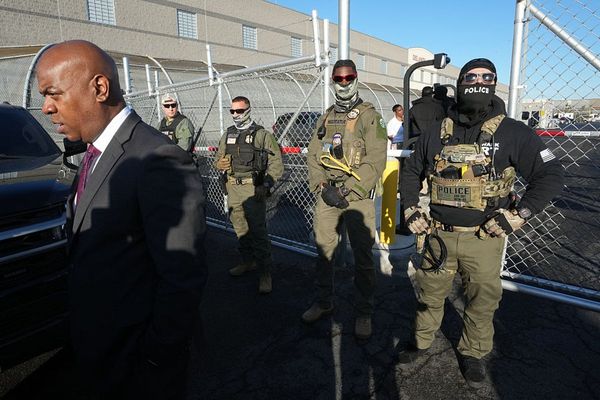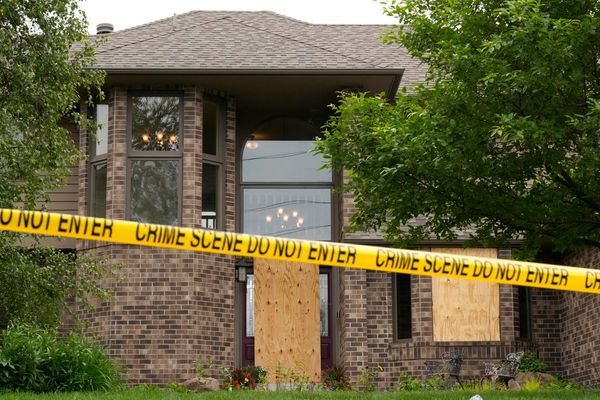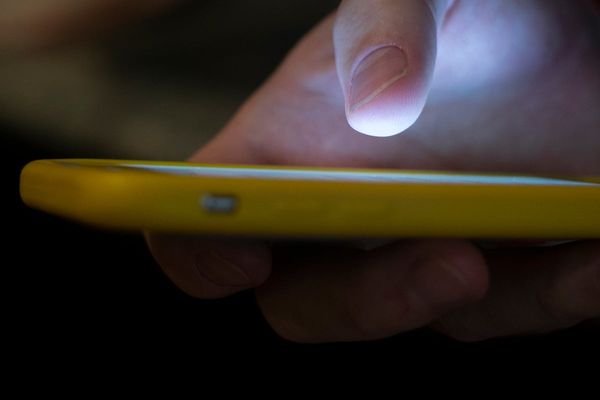
It had been a good few weeks for Trevor and Susan Parry. They caught up with their grandchildren, whom they had not hugged for months during the spring and summer lockdown, and took a brief holiday on the coast at Porthcawl, south Wales.
On Tuesday they were to be found taking in the view of Caerphilly Castle – and a queue of people trying to get into the Iceland supermarket – feeling gloomy at the prospect of their area going into Wales’s first local lockdown because of coronavirus.
“I think in our heart of hearts we knew it was coming,” said Trevor, 65, a retired caretaker. “Over the past few weeks the pubs have been heaving and the hordes have been coming back from abroad. It was inevitable.”

“They should have stopped people going abroad and then packing into the pubs,” said Susan, a 66-year-old retired carer. “We’re going to be stuck inside again. It was hard not seeing our grandchildren properly. They could only knock on the window and wave at us. That hurt.”
There was a sense of concern, confusion and anger on the streets of Caerphilly: concern at the rapid rise in coronavirus cases and the warnings that hospital admissions would almost certainly follow in a few weeks’ time; confusion that people were not to be allowed to enter or leave the county borough without good reason even while pubs, shops gyms, cafes and restaurants could stay open; and anger at those bearing the brunt of the blame for the fresh crisis, the young partygoers and returnees from holidays abroad.
“People have brought it on themselves,” said Dean Evans, 52, who was shopping with his mother, Anne Williams, 75. “They haven’t been listening. We’ll end up being stuck in the house all the time. It’s a nightmare. You get so depressed.”
The Welsh government has ordered people to wear masks. “It’s too late for that,” said Williams. “You’re supposed to wear masks on the bus but people ignore that.”
There are areas of severe deprivation in the county borough and many people have significant health problems.

John Beechey, 65, a labourer, had just placed a bet in one of the town’s bookies. “I’ve got a bad heart and diabetes. I’ve had one Covid false alarm already. I expect there’ll be more over the winter.”
At a press conference in Cardiff, the Welsh health minister, Vaughan Gething, said the Covid-19 rate in Caerphilly had risen to 72.9 cases per 100,000 people – the highest rate in Wales and one of the highest in the UK.
He put the blame on house parties and people returning from holiday abroad and said other parts of Wales were on a “watchlist”. Community testing was starting in the nearby Rhondda Valley.
Avril Thomas, 69, a retired independent social worker, said the lockdown was no surprise. “You only have to drive through town and you see so many people out and about enjoying themselves. I think people have been confused over what they can and cannot do.”
In recent days the UK has seen a sudden sharp increase in Covid-19 infection numbers, leading to fears that a second wave of cases is beginning.
Epidemics of infectious diseases behave in different ways but the 1918 influenza pandemic that killed more than 50 million people is regarded as a key example of a pandemic that occurred in multiple waves, with the latter more severe than the first. It has been replicated – albeit more mildly – in subsequent flu pandemics. Until now that had been what was expected from Covid-19.
How and why multiple-wave outbreaks occur, and how subsequent waves of infection can be prevented, has become a staple of epidemiological modelling studies and pandemic preparation, which have looked at everything from social behaviour and health policy to vaccination and the buildup of community immunity, also known as herd immunity.
Is there evidence of coronavirus coming back in a second wave?
This is being watched very carefully. Without a vaccine, and with no widespread immunity to the new disease, one alarm is being sounded by the experience of Singapore, which has seen a sudden resurgence in infections despite being lauded for its early handling of the outbreak.
Although Singapore instituted a strong contact tracing system for its general population, the disease re-emerged in cramped dormitory accommodation used by thousands of foreign workers with inadequate hygiene facilities and shared canteens.
Singapore’s experience, although very specific, has demonstrated the ability of the disease to come back strongly in places where people are in close proximity and its ability to exploit any weakness in public health regimes set up to counter it.
In June 2020, Beijing suffered from a new cluster of coronavirus cases which caused authorities to re-implement restrictions that China had previously been able to lift. In the UK, the city of Leicester was unable to come out of lockdown because of the development of a new spike of coronavirus cases. Clusters also emerged in Melbourne, requiring a re-imposition of lockdown conditions.
What are experts worried about?
Conventional wisdom among scientists suggests second waves of resistant infections occur after the capacity for treatment and isolation becomes exhausted. In this case the concern is that the social and political consensus supporting lockdowns is being overtaken by public frustration and the urgent need to reopen economies.
However Linda Bauld, professor of public health at the University of Edinburgh, says “‘Second wave’ isn’t a term that we would use at the current time, as the virus hasn’t gone away, it’s in our population, it has spread to 188 countries so far, and what we are seeing now is essentially localised spikes or a localised return of a large number of cases.”
The overall threat declines when susceptibility of the population to the disease falls below a certain threshold or when widespread vaccination becomes available.
In general terms the ratio of susceptible and immune individuals in a population at the end of one wave determines the potential magnitude of a subsequent wave. The worry is that with a vaccine still many months away, and the real rate of infection only being guessed at, populations worldwide remain highly vulnerable to both resurgence and subsequent waves.
Michael Roberts, who runs the Urban Bar BQ Co, took the decision last week to offer only takeaways. “We saw this coming and acted to protect customers, staff, the community and our business.” He said not all licensed premises had been so pro-active. “We know some haven’t bothered with trace and track.”

So many parts of the community expect to be affected. Will Rees, the volunteer director of Bedwas rugby club, said the club had been hit this year by flooding and Covid-19. The club was struggling because of a lack of income, it feared losing potential young players, and worried about older members missing their friends. “It’s potentially disastrous; 2020 has been the most challenging year in the club’s 130-year history,” said Rees.

Businesses are worried about the impact of the new lockdown. Nicola Downie, who runs a floristry shop opposite the castle, said: “It’s very worrying. The town is not the same place it was this time last year. We hope we’ll be able to keep going.”
Jackie Stephens, 56, who has learning disabilities, said that since February she had not been able to go to a day centre she liked to visit. “I’ve been crying at this new lockdown,” she said. “I want to see my friends.”
Rhydian Birkinshaw, 25, an operations manager at the Wales Millennium Centre, in Cardiff, who is on furlough, suggested it was not fair to put the blame entirely on young people. “Some have been doing silly things. Police had to break up a rave recently. Going to a rave is not on. Equally, elderly neighbours continued to go to friends’ houses in lockdown and as soon as they could, were off on the bus up to Blackwood.
“Everyone has been doing something that has bent the rules. You can’t say it’s the rave or the flight from Zante or the people popping up to Blackwood to visit their friends. It’s a combination – it’s everyone.”
• This article was amended on 9 September 2020 to correct a hoards/hordes homophone in the line “the hordes have been coming back from abroad”.







